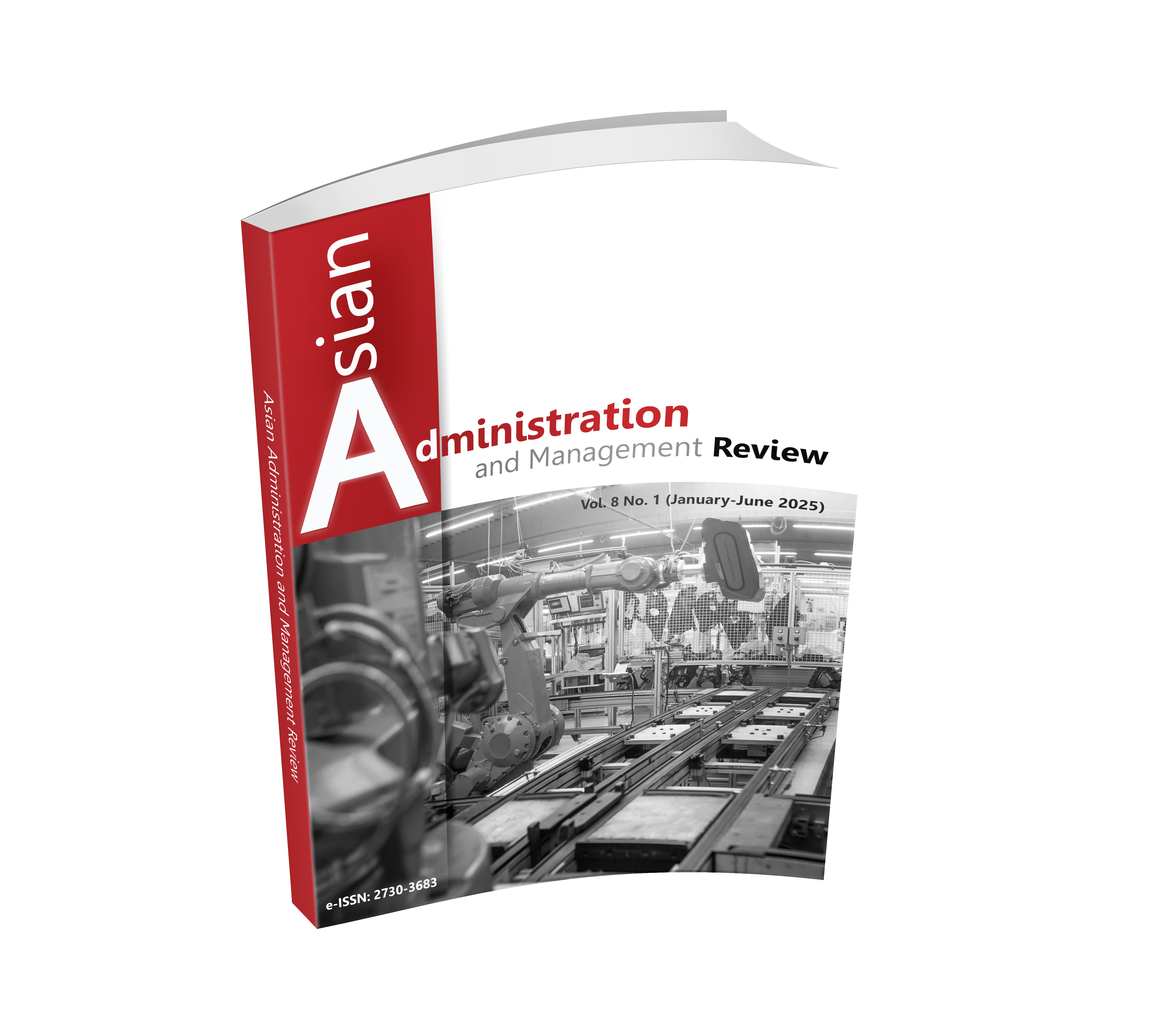DEVELOPING A STRATEGIC BUSINESS MODEL FOR LOGISTICS SERVICE PROVIDER AFTER THE COVID-19 OUTBREAK IN THAILAND
DOI:
https://doi.org/10.14456/aamr.2025.1Keywords:
Logistics Service Provider, Eastern Economic Corridor, Industrial Logistics Performance Index, Logistics ScorecardAbstract
The COVID-19 pandemic severely affected Thailand’s Logistics Service Providers (LSPs), requiring businesses to adapt rapidly to changing conditions. This study evaluates the pandemic's impact on Thai LSPs, examines factors influencing their adaptation, and proposes a post-pandemic business strategy model. A mixed-methods approach was employed, with qualitative data from 15 experts and quantitative data from 385 LSPs analyzed using SPSS and AMOS. Confirmatory Factor Analysis and Structural Equation Modeling were used to test hypotheses and investigate relationships among variables. The findings reveal the significant disruptions to supply and demand within the logistics sector caused by COVID-19, highlighting the necessity for operational changes among LSPs. The study underscores the importance of various factors in shaping adaptation strategies, providing empirical support for the proposed framework. The resulting business strategy model serves as a practical guide for LSPs to navigate challenges and opportunities post-pandemic. This research enhances the understanding of crisis management and organizational resilience, contributing to logistics industry discussions on supply chain adaptability and sustainability. The proposed strategies offer valuable insights for logistics professionals and policymakers to mitigate future disruptions and strengthen supply chain resilience.
Downloads
References
Ahdika, A. (2017). Improvement of Quality, Interest, Critical, and Analytical Thinking Ability of Students through the Application of Research Based Learning (RBL) in Introduction to Stochastic Processes Subject. International Electronic Journal of Mathematics Education, 12(2), 167-191.
Alanzi, S. (2018). Pestle Analysis Introduction. Manchester: University of Salford.
Callarman, S. (2020). Logistics Service Providers for Ecommerce: Your Partners for Faster, Scalable Growth. Retrieved from www.shipbob.com/blog/logistics-service-provider/#:~:text=What%20is%20a%20logistics%20service,order%20fulfillment%2C%20and%20shipping%20orders.
Department of Primary Industries and Mines. (2017). Handbook of Logistics and Supply Chain Efficiency and Potential Assessment. Retrieved from https://dol.dip.go.th/uploadcontent/DOL/Pert/ILPI_Handbook_2560.pdf.
Electronic Transactions Development Agency. (2021). Thai e-Commerce in the Post-COVID-19 Era. Retrieved from www.etda.or.th/th/Useful-Resource/Knowledge-Sharing/Perspective-on-Future-of-e-Commerce.aspx.
Exemplars in Global Health. (2020). How Did Thailand Respond to the Covid-19 Pandemic?. Retrieved from www.exemplars.health/emerging-topics/ecr/thailand/how-did-thailand-respond.
Fabbe-Costes, N., & Roussat, C. (2011). Supply Chain Integration: Views from a Logistics Service Provider. Supply Chain Forum: An International Journal, 12(2), 20-30.
Frias, A., Simões-Marques, M., Água, P., & Correia, A. (2023). Logistics future trends and their transformative impact. Human Factors and Systems Interaction, 84, 217-226.
Garrett, R., & Covin, J. (2007). A Model of Corporate Entrepreneurship as a Strategic Adaptation Mechanism. In G. Lumpkin, & J. Katz. (eds.). Entrepreneurial Strategic Processes (Advances in Entrepreneurship, Firm Emergence and Growth (pp. 9-31). Leeds: Emerald Group Publishing Limited.
Gültekin, B., Demir, S., Gunduz, M., Cura, F., & Özer, L. (2022). The logistics service providers during the COVID-19 pandemic: The prominence and the cause-effect structure of uncertainties and risks. Computers & Industrial Engineering, 165, 107950.
Hair, J., Black, W., Babin, B., & Anderson, R. (2010). Multivariate Data Analysis. 7th ed. New York: Pearson.
Heskett, J. (1977). Logistics—Essential to Strategy. Massachusetts: Harvard Business Publishing.
Hirata, E., & Matsuda, T. (2022). Uncovering the impact of COVID-19 on shipping and logistics. Maritime Business Review, 7(4), 305-317.
Interlake Mecalux. (2020). Logistics providers: functions and challenges. Retrieved from www.interlakemecalux.com/blog/logistics-providers-warehouses.
International Finance Corporation. (2020). The Impact of COVID-19 on Logistics. Retrieved from www.ifc.org/content/dam/ifc/doc/mgrt/ifc-covid19-logistics-final-web.pdf.
Jenkins, A. (2023). What Is a Logistics Service Provider (LSP)? Types and Services Offered. Retrieved from www.netsuite.com/portal/resource/articles/inventory-management/logistics-service-providers.shtml.
Kara, E. (2018). A Contemporary Approach for Strategic Management in Tourism Sector: PESTEL Analysis on The City Muğla, Turkey. Journal of Business Research Turk, 10(2), 598-608.
Kashem, M., Shamsuddoha, M., & Nasir, T. (2024). Digital-Era Resilience: Navigating Logistics and Supply Chain Operations after COVID-19. Businesses, 4(1), 1-17.
Klomjit, P. (2013). Logistics-Supply Chain: Introduction to Design and Management. Bangkok: SE-EDUCATION Public Company Limited.
Kobelsky, K., Richardson, V., Smith, R., & Zmud, R. (2008). Determinants and Consequences of Firm Information Technology Budgets. The Accounting Review, 83(4), 957-995.
Kongsup, K., & Ongkunaruk, P. (2022). The value chain analysis and the effect of COVID-19 on a small-sized blue crab manufacturer: A case study in Thailand. Kasetsart Journal of Social Sciences, 43(2), 409-416.
Kuleshov, D. (2023). Fundamentals of the formation of the adaptation mechanism of service enterprises to the conditions of a competitive market environment. Retrieved from https://s-lib.com/en/issues/eiu_2023_01_t2_a15/.
Luypornsuksawang, T., Charoenwiriyakul, C., Siriwattana, S., & Suwannapirom, S. (2023). Impact of the coronavirus disease 2019 epidemic on sea freight. The Journal of Development Administration Research, 13(3), 717-729.
Lynch, R. (2009). Strategic Management. 5th ed. Essex: Financial Times Prentice Hall.
Matovic, I. (2020). PESTEL Analysis of External Environment as a Success Factor of Startup Business. Retrieved from http://society.education/wp-content/uploads/2020/10/015IM.pdf.
Mishra, A., Ergün, M., Okoth, B., Korucuk, S., Aytekin, A., & Karamaşa, Ç. (2024). Rating pressure factors affecting logistics systems during the pandemic and the ideal logistic decision selection under the Pythagorean fuzzy environment. Kybernetes, 53(7), 2247-2278.
Opasanon, S. (2020). Logistics Management in Pandemic Crisis. Retrieved from www.tbs.tu.ac.th/wp-content/uploads/2020/04/การจัดการโลจิสติกส์ในช่วงวิกฤตโรคระบาด.pdf.
Proykratok, W., Chuchottaworn, C., & Ngamcharoen, W. (2024). The Evaluation and Development of Thai Logistics Service Providers to Logistics Management Excellence. Journal of Logistics, Informatics and Service Science, 11(1), 209-227.
Punia, B. (2005). Executive personality and visioning effectiveness. Journal of Management Research, 5(1), 6-19.
Rakpendham, P., Rattakul, Y., & Chantapong, S. (2020). Impact of the COVID-19 Crisis on New Business Trends: Transportation in the Next Normal. Retrieved from www.bot.or.th/th/research-and-publications/articles-and-publications/articles/Article_14Apr2020.html.
Scala, B., & Lindsay, C. (2021). Supply chain resilience during pandemic disruption: Evidence from healthcare. Supply Chain Management, 26(6), 672-688.
Sen, D. (1986). Strategic Planning and Large Information Systems Installations. Industrial Management & Data Systems, 86(7/8), 3-15.
Siddiqui, D. (2020). COVID-19 Impact on the Logistics Industry. Retrieved from www.diva-portal.org/smash/get/diva2:1529761/FULLTEXT01.pdf.
Siyodia, R., & Chakraborty, R. (2022). Developing a Framework for New-Normal Supply Chain Management. Journal of Development Research, 15(1), 23-34.
Sousa, G., & Castañeda-Ayarza, J. (2022). PESTEL analysis and the macro-environmental factors that influence the development of the electric and hybrid vehicles industry in Brazil. Case Studies on Transport Policy, 10(1), 686-699.
Świtała, M. (2016). Typology of Logistics Service Providers According to the Level of Innovativeness. Handel Wewnętrzny, 1(360), 317-333.
Tabachnick, B., & Fidell, L. (2007). Using Multivariate Statistics. 5th ed. New York: Allyn and Bacon.
Vivaldini, M. (2023). The effect of logistical immediacy on logistics service providers' (LSPs') business. Benchmarking: An International Journal, 30(3), 899-923.
Yüksel, İ. (2012). Developing a Multi-Criteria Decision Making Model for PESTEL Analysis. International Journal of Business and Management, 7(24), 52-66.

Downloads
Published
How to Cite
Issue
Section
License
Copyright (c) 2025 Authors

This work is licensed under a Creative Commons Attribution-NonCommercial-NoDerivatives 4.0 International License.











.png)


